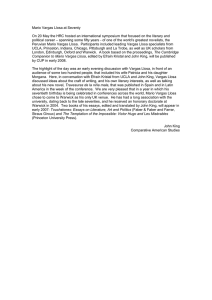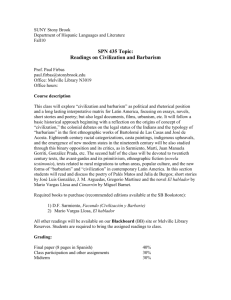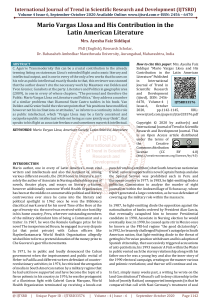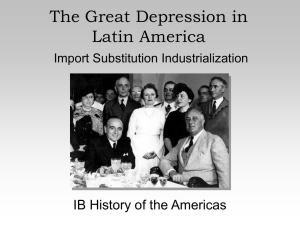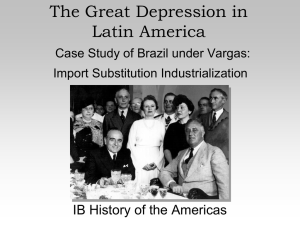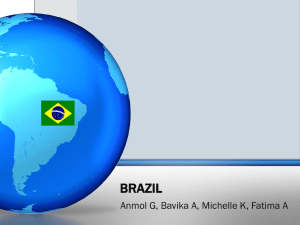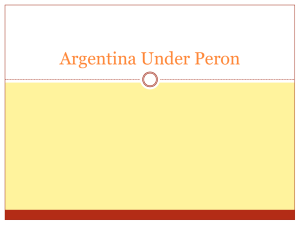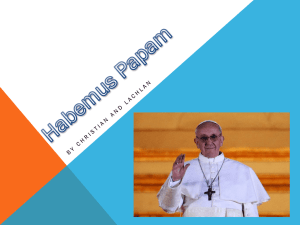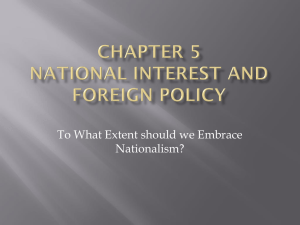Mario Vargas Llosa - culturespanishamerica
advertisement
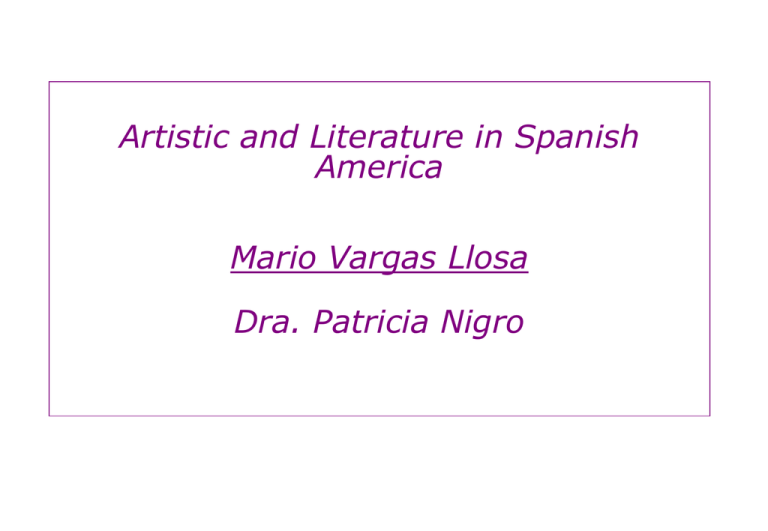
Artistic and Literature in Spanish America Mario Vargas Llosa Dra. Patricia Nigro Mario Vargas Llosa (1936-) • Jorge Mario Pedro Vargas Llosa was born to a middle-class family in 1936, in the Peruvian provincial city of Arequipa. He was the only child of Ernesto Vargas Maldonado and Dora Llosa Ureta (the former a mestizo pilot, the latter the daughter of an old criollo family), who separated a few months before his birth. • After Mario's birth, his father revealed that he was having an affair with a German woman; consequently, Mario has two younger half-brothers: Enrique and Ernesto Vargas. Mario Vargas Llosa (1936-) • Vargas Llosa lived with his maternal family in Arequipa until a year after his parents' divorce, when his maternal grandfather was named honorary consul for Perú in Bolivia. • With his mother and her family, Vargas Llosa then moved to Cochabamba, where he spent the early years of his childhood. His maternal family, the Llosas, were sustained by his grandfather, who managed a cotton farm. As a child, Vargas Llosa was led to believe that his father had died—his mother and her family did not want to explain that his parents had separated. Mario Vargas Llosa (1936-) • During the government of Peruvian President José Bustamante y Rivero, Vargas Llosa's maternal grandfather obtained a diplomatic post in the Peruvian coastal city of Piura and the entire family returned to Perú. While in Piura, Vargas Llosa attended elementary school at the religious academy Colegio Salesiano. Mario Vargas Llosa (1936-) • In 1946, at the age of ten, he moved to Lima and met his father for the first time. His parents reestablished their relationship and lived in Magdalena del Mar, a middle-class Lima suburb, during his teenage years. • While in Lima, he studied at the Colegio La Salle, a Christian middle school, from 1947 to 1949. Mario Vargas Llosa (1936-) • When Vargas Llosa was 14, his father sent him to the Leoncio Prado Military Academy in Lima. A year before his graduation, Vargas Llosa began working as an amateur journalist for local newspapers. • He withdrew from the military academy and finished his studies in Piura, where he worked for the local newspaper, La Industria, and witnessed the theatrical performance of his first dramatic work, La huida del Inca. Mario Vargas Llosa (1936-) • In 1953, he enrolled in Lima's National University of San Marcos to study law and literature. • He married Julia Urquidi, his maternal uncle's sister-in-law, in 1955 at the age of 19; she was 13 years older. • He began his literary career in 1957 with the publication of his first short stories, "The Leaders" ("Los jefes") while working for two Peruvian newspapers. • Thereafter, his stories began to appear in Peruvian literary reviews. Mario Vargas Llosa (1936-) • Upon his graduation in 1958, he received a scholarship to study at the Complutense University of Madrid in Spain. • In 1960, after his scholarship had expired, he moved to France under the impression that he would receive a scholarship to study there; however, his request was denied. • Despite Mario and Julia's unexpected financial status, the couple decided to remain in Paris where he began to write prolifically. Their marriage lasted only a few more years, ending in divorce in 1964. Mario Vargas Llosa (1936-) • A year later, Vargas Llosa married his first cousin, Patricia Llosa, with whom he had three children: Álvaro Vargas Llosa (born 1966), a writer and editor; Gonzalo (born 1967), a businessman; and Morgana (born 1974), a photographer. Mario Vargas Llosa (1936-) • Vargas Llosa’s first novel, La ciudad y los perros (1963; “The City and the Dogs”; Eng. trans. The Time of the Hero), was widely acclaimed. Translated into more than a dozen languages, this novel, set in the Leoncio Prado Military School, describes adolescents striving for survival in a hostile and violent environment. • The corruption of the military school reflects the larger malaise afflicting Perú. The book was filmed twice, in Spanish (1985) and in Russian (1986), the second time as Yaguar. Mario Vargas Llosa (1936-) • The novel La casa verde (1966; The Green House), set in the Peruvian jungle, combines mythical, popular, and heroic elements to capture the sordid, tragic, and fragmented reality of its characters. • Los cachorros (1967; The Cubs, and Other Stories, filmed 1973) is a psychoanalytical portrayal of an adolescent who has been accidentally castrated. Mario Vargas Llosa (1936-) • Conversación en la catedral (1969; Conversation in the Cathedral) deals with Manuel Odría’s regime (1948–56). • The novel Pantaleón y las visitadoras (1973; “Pantaleón and the Visitors”; Eng. trans. Captain Pantoja and the Special Service, filmed 2000) is a satire of the Peruvian military and religious fanaticism. Mario Vargas Llosa (1936-) • His semiautobiographical novel La tía Julia y el escribidor (1977; Aunt Julia and the Scriptwriter, filmed 1990 as Tune in Tomorrow) combines two distinct narrative points of view to provide a contrapuntal effect. • Vargas Llosa also wrote a critical study of the fiction of Gabriel García Márquez in García Márquez: Historia de un deicidio (1971); “García Márquez: Story of a God-Killer”). Mario Vargas Llosa (1936-) • After living three years in London, he was a writer-in-residence at Washington State University in 1969. • In 1970, he settled in Barcelona. He lectured and taught widely throughout the world. • His critical essays in English translation were published in 1978. La guerra del fin del mundo (1981; The War of the End of the World), an account of the 19th-century political conflicts in Brazil, became a best seller. Mario Vargas Llosa (1936-) • Three of his plays— La señorita de Tacna (1981; The Young Lady of Tacna), Kathie y el hipopótamo (1983; Kathie and the Hippopotamus), and La chunga (1986; “The Jest”; Eng. trans. La chunga)— were published in Three Plays (1990). Mario Vargas Llosa (1936-) • Like many Latin American authors, Vargas Llosa has been politically active throughout his career; over the course of his life, he has gradually moved from the political left towards the right. • While he initially supported the Cuban revolutionary government of Fidel Castro, he later became disenchanted. • He ran for the Peruvian presidency in 1990 with the center-right Frente Democrático (FREDEMO) coalition, advocating neoliberal reforms. Mario Vargas Llosa (1936-) • In 1990, he lost his bid for the presidency of Perú in a runoff against Alberto Fujimori, an agricultural engineer and the son of Japanese immigrants. • Vargas Llosa wrote about this experience in El pez en el agua: memorias (1993; A Fish in the Water: A Memoir). Mario Vargas Llosa (1936-) • He has subsequently supported moderate conservative candidates. • He became a citizen of Spain in 1993 and was awarded the Cervantes Prize in 1994. Despite his new nationality, he continued to write about Perú in such novels as Los cuadernos de don Rigoberto (1997; The Notebooks of Don Rigoberto). Mario Vargas Llosa (1936-) • His later works include the novels La fiesta del chivo (2000; The Feast of the Goat), El paraíso en la otra esquina (2003; The Way to Paradise), 2006 – Travesuras de la niña mala (The Bad Girl, 2007). • Other non fiction works are 2004 – La tentación de lo imposible (The Temptation of the Impossible); 2009 – El Viaje a la Ficción (A trip to fiction). Mario Vargas Llosa (1936-) • Many of Vargas Llosa's works are influenced by the writer's perception of Peruvian society and his own experiences as a native Peruvian. Increasingly, he has expanded his range, and tackled themes that arise from other parts of the world. Another change over his career has been a shift from a style and approach associated with literary modernism to a sometimes playful postmodernism. Mario Vargas Llosa (1936) • Mario Vargas Llosa is considered a major Latin American writer, alongside other greats such as Julio Cortázar, Jorge Luis Borges, Gabriel García Márquez and Carlos Fuentes. In his book The New Novel in Latin America (La Nueva Novela), Fuentes offers an in-depth literary criticism of the positive influence Vargas Llosa's work has had on Latin American literature. Mario Vargas Llosa (1936) • Mario Vargas Llosa won the Nobel Prize in Literature in 2010. • He very well deserved it because of his wonderful and huge work as a writer. • His last novel is El sueño del celta (2010) (The dream of the celt). Mario Vargas Llosa (1936) • Mario Vargas Llosa has been working as a journalist since he was a teenager. • Now he writes for important newspapers as The New York Times or El País (Spain). • Several books collect his articles and interviews such as • Diario de Irak (A Journal of Irak, 2003); Israel-Palestina. Paz o Guerra Santa (2006); Sables y utopías (2009).
